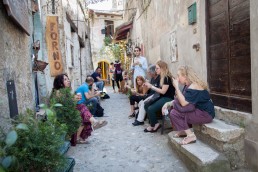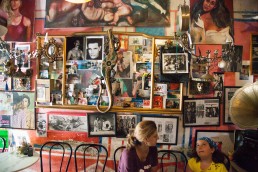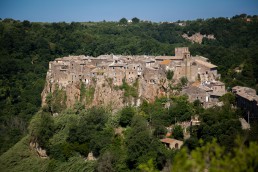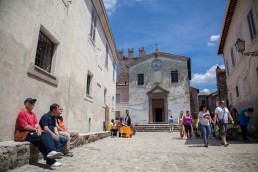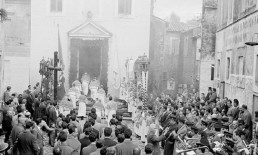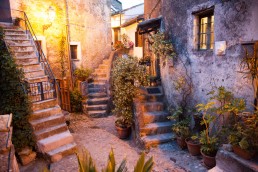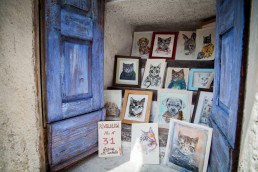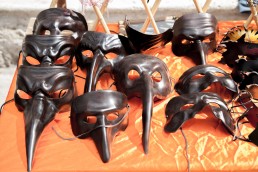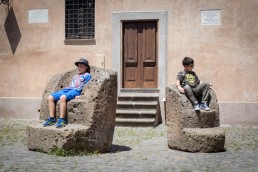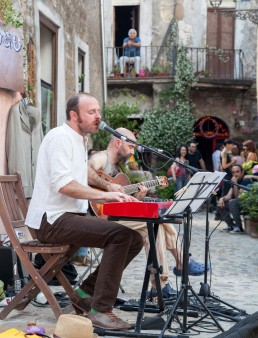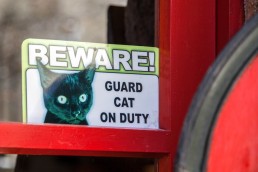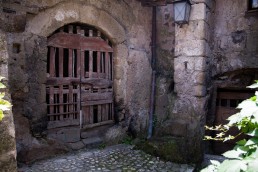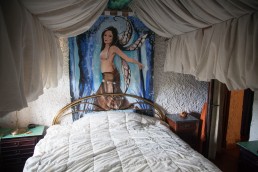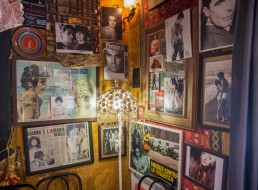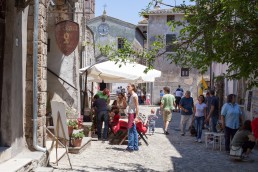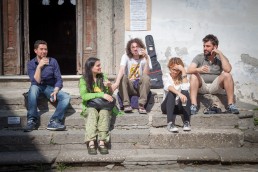Dramatically perched on a sheer-sided outcrop of volcanic rock just an hour's drive from Rome, the medieval village of Calcata looks like the setting for a disturbing fairy tale, with all the eccentric characters in residence.
IMAGINE ALL THE casinos of Las Vegas suddenly bolted shut. How would Siem Reap fair if Angkor Wat was not just down the road. And what would become of Niagara Falls (the city) without Niagara Falls (the falls)?
Imagine, then, Calcata’s dilemma when the parish priest, one gloomy day in 1983, announced that the foreskin of Jesus Christ, which he had kept in a shoebox at the back of his wardrobe, had “vanished”.
The santissimo prepuzio, the “blessed foreskin”, had drawn pilgrims to the ancient Italian village for centuries, and the fate of the holy relic remains a mystery to this day. Calcata, however, shrugged off losing our planet’s weirdest visitor attraction — the only scrap of the son of God’s flesh conceivably left on Earth before his ascent to Heaven.
Though the hill-top hamlet, located just 50 kilometres north of Rome, had long been a spiritual stopover for the devout, by the early ’80s it was well on its way to reinvention anyway. In the years before it mislaid the miraculous membrane, the community had embraced all things new age, welcoming bohemians and hippies, artists, musicians and kooks.
Outsiders were now calling Calcata il paese di fricchettoni, or “the village of freaks”.
THE DRIVE FROM ROME today is uneventful until we round a green-canopied bend to discover a scene straight out of Game of Thrones. Perched on a sheer-sided stump of volcanic rock that rises 40 metres from a forested river valley, Calcata’s tightly packed disarray of medieval houses and cave dwellings appears to have burst from the land itself.
If a trio of flame-spitting dragons were to flap overhead, nobody would be too surprised.
Entrance to the fortress-like village is via an arched stone gate and a narrow passageway, meaning no cars inside. The fortified track zigs and then zags and the story of Calcata and the redeemer’s foreskin begins here — in the 16th century, in a dank cave-cum-barn halfway up the cobbled incline.
According to folklore, a German mercenary, wounded during the 1527 Sack of Rome, was captured near Calcata and imprisoned in the cave. The solder’s swag contained a silver reliquary that he hid under cattle dung and straw, and was unable to recover before his release and subsequent death from his injuries.
The reliquary was only discovered 30 years later, but it placed Calcata firmly on the path of righteousness.
THE PASSAGEWAY OPENS today on to a compact, sun-bleached piazza that — this being a Saturday afternoon — buzzes with day-trippers from the Italian capital.
Market stalls punt cracked-turquoise and coral jewellery, leather plague-doctor masks and flower-child trinkets. A two-man band tunes up and teens scoff pizza slices and gelato on the stone steps of the Church of the Most Holy Name of Jesus, from which the relic would be paraded each year on January 1, the Day of the Holy Circumcision.
Children scuttle and chuckle around sculptures of Etruscan thrones in the square. The muscular artworks were coaxed from the same volcanic tufo stone on which Calcata sits so dramatically, and their creator — portly artist Costantino Morosin — mingles like the village’s unofficial mayor, his long grey hair pulled into a topknot.
Meanwhile, someone, somewhere, is torturing O Sole Mio on a trumpet, and though I cannot get a signal on my phone, I can buy a “teleportation hat” — and a werewolf mask, and “horror teeth” — in the magic shop.
Calcata drone footage. Video: Marco Marano/YouTube
THERE ARE NO hotels in the village but I’ve booked a sight-unseen room in a private home through Calcata’s suitably lo-fi website. The owner calls her cliff-edge dwelling L’Isola Che Non C’era, or “The Island That Wasn’t There” (it’s the house just right of centre in the opening photograph).
L’Isola has three for-rent bedrooms, including the “Room of the Witch Nilde” (with faux cobwebs and dollar-shop Halloween decor) and the “Refuge of Tinkerbell and Peter Pan” (brighter, with woodland murals).
Disconcertingly, I’ve been allocated the “Room of the Fairy Nimir”, which has a crude painting of a winged, raven-haired and ample-bosomed sylph hanging over the bed.
Think of the appalling Child Catcher in Chitty Chitty Bang Bang, or the vengeful Pied Piper of legend, luring youngsters away from their families, never to be seen again
In 2007, the New York Times announced that Calcata “may be the grooviest village in Italy”. After dark, however, when the city dwellers have tootled home, there is something satisfyingly creepy about this languorous corner of Lazio.
With only about 60 permanent residents (including a kohl-eyed sexagenarian Egyptologist who lives in a cave with her crows — and many believe to be a witch), Calcata is like a film set for a disturbing fairy tale.
Think of the appalling Child Catcher in Chitty Chitty Bang Bang, or the vengeful Pied Piper of legend, luring youngsters away from their families, never to be seen again. The truth is nearly as strange: once upon a time, Calcata’s residents did disappear — and not just the children, but all of them!
CALCATA’S 20TH-CENTURY reinvention began with the devastating Messina earthquake that claimed at least 75,000 lives in 1908. In the decades that followed, communities across Italy were surveyed for their vulnerability to destructive acts of God and Calcata was deemed unsafe in 1935. A new town, Calcata Nuova, would be built nearby and the village demolished.
New housing was not actually ready until the late 1960s, and abandoned Calcata Vecchia (“Old Calcata”) quickly attracted the interest of the counterculture, with hippies and slackers squatting in empty properties before purchasing them for a song. When the condemnation order was lifted, the new residents — both Italian and from around the world — held sway over their very own bohemian village.
“I’m amazed at the people who are drawn here. I don’t think anyone is normal — we’re all crazy, or at least different”
American resident Pancho Garrison
Calcata is humming again come the Sunday afternoon, another batch of visitors browsing its quirky galleries and dining in the handful of restaurants. One popular eatery is Grotta dei Germogli (“Sprout Cave”) run by 66-year-old Pancho Garrison, a sprightly and sprite-like former dancer from Texas who arrived in Rome in 1976 and “kept falling in love”. He discovered Calcata in the early 1980s.
Garrison believes the village — which through the years “has been called the village of artists, of druggies, of sex fiends, you name it”, he says — inspires creativity and attracts only a certain type of character. The pre-Roman Faliscans used the hilltop as a sacred ritual site for a reason, the American argues, and a mysterious force emanates from the volcanic stump.
“There’s a unique, very strange energy here,” says Garrison, who serves offbeat Italian-inspired fusion dishes in his restaurant. “The ancients would not live in Calcata. It was a place of worship. I’m amazed at the people who are drawn here. I don’t think anyone is normal — we’re all crazy, or at least different. The people here want a place where their craziness can come out.”
DUTCH PUPPET MAKER Marijcke van der Maden, who is also in her 60s and made Calcata her home in the early ’80s, is the driving force behind Calcata’s non-profit cultural centre, Il Granarone, which is based in the village’s restored 17th-century granary and today holds jazz concerts, jam sessions and theatrical and literary events. While she enjoys living in Calcata for its human scale (“like my puppets”), she says it is not for everyone.
“They come, they fall in love with Calcata and move in,” she says of occasional newcomers, “but things quickly become too complicated. We recognise quickly the kind of people who will stay and who will leave within six months.”
One of Calcata’s most flamboyant personalities must be 70-something Italian actor Gianni Macchia, whose coffee shop-cum-bar is a shrine to … well, to Gianni Macchia, its interior a dense collage of photographs, newspaper cuttings and mementos of a career in racy B-movies such as Confessions of Emanuelle, Love Me, Baby, Love Me!, When Love is Lust and A Wrong Way to Love.
Macchia, on this day, is shooting in Rome, but that’s okay because in the time it takes to down a double espresso I’ve seen quite enough of him. There he is with Bianca Jagger; there he is on a motorbike; and stripped to the waist; and grappling with a female co-star in the rain; wearing only a codpiece; sometimes wearing nothing at all …
Which brings us back — kind of, in a way — to the foreskin.
WHEN THE PRIEST announced in 1983 that the relic was gone, he declared that “sacrilegious thieves have taken it from my home”, but the popular belief is that the santissimo prepuzio was secreted away to the Vatican.
Though the relic remained in Calcata for most of the 20th century, Pope Leo XIII — fearing it would inspire “an irreverent curiosity” — had announced as early as 1900 that anyone who spoke or wrote of it would face excommunication. In Calcata, at least, he was ignored.
Today, however, perhaps the strangest thing about the missing foreskin is not that nobody here seems to have even a clue about its whereabouts, but that nobody appears to care. Resilient Calcata has moved on.
Heading back to L’isola Che Non C’era, I buy wine from a sweet but doddery old gent who, from his hole-in-the-wall shop just off the piazza, refills empty bottles from a large polyethylene canister, smashing in new stoppers with his mallet.
Come evening, the cheap wine will do its trick, a full moon will illuminate the valley and the missing off-cut of Christ will be forgotten.
In the Room of the Fairy Nimir, l sleep soundly under the gaze of a schoolboy-fantasy female, content that such a joyfully odd place as Calcata exists. And all is well with the cosmos. ◉
This travel story ran in Post Magazine, October 2016. Download PDF.
SHARE


